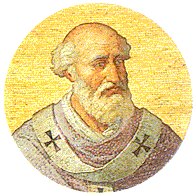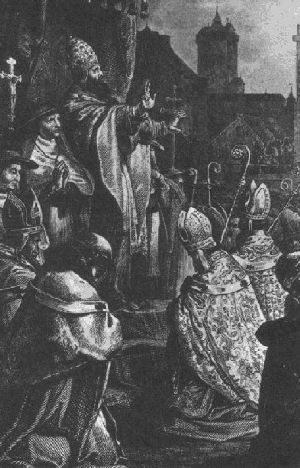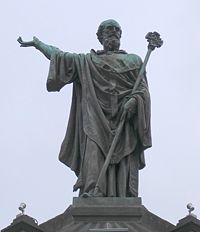Urban II
| Urban II | |
|---|---|

| |
| Birth name | Otho of Lagery |
| Papacy began | March, 1088 |
| Papacy ended | July 29, 1099 |
| Predecessor | Victor III |
| Successor | Paschal II |
| Born | 1042 Lagery, France |
| Died | July 29 1099 Rome, Italy |
| Other popes named Urban | |
Pope Urban II (1042 – July 29, 1099) born Otho of Lagery (alternatively: Otto or Odo), was Pope from 1088 to July 29, 1099. He is most known for starting the First Crusade (1095–1099) and setting up the modern day Roman Curia, in the manner of a royal court, to help run the Church. He was one of the most prominent and active supporters of the Gregorian reforms, especially as legate in Germany in 1084, and was among the few whom Gregory VII nominated as possible successors to be Pope. Desiderius, abbot of Monte Cassino, who became Pope Victor III (1086–87) was chosen Pope initially, but after his short reign, Odo was elected Pope Urban II by acclamation (March 1088) at a small meeting of cardinals and other prelates held in Terracina. He took up the policies of Pope Gregory VII, and while pursuing them with determination, showed greater flexibility, and diplomatic finesse.
| Styles of Pope Urban II | |

| |
| Reference style | His Holiness |
| Spoken style | Your Holiness |
| Religious style | Holy Father |
| Posthumous style | Blessed |
At the outset, he had to reckon with the presence of the powerful antipope Clement III (1080, 1084–1100) in Rome; but a series of well-attended synods held in Rome, Amalfi, Benevento, and Troia supported him in renewed declarations against simony, lay investiture, and clerical marriages, and a continued opposition to Emperor Henry IV (1056–1105). On the one hand, Urban II tried to strengthen the temporal authority of the Church. He also tried to raise standards of clerical conduct and to make personal spirituality a dominant concern.
Biography
He was born into nobility in France at Lagery (near Châtillon-sur-Marne) and was church-educated. He was archdeacon of Rheims when, under the influence of his teacher Bruno of Cologne, he resigned and entered the monastery of Cluny where he rose to be prior. In 1078, Pope Gregory VII (1073–85) summoned him to Italy and made him cardinal-bishop of Ostia. He was elected Pope in March 1088, in succession to Victor III. He was a staunch supporter of the reforms of Gregory VII, which aimed at the same time to improve the moral and spiritual life and integrity of priests and bishops while at the same time consolidating the church's temporal power by asserting not only its independence from secular authority, but its superiority over them. Reforms included banning the selling of ecclesiastical offices (simony) and lay (that is, royal) appointment or investiture of bishops. Only the Church would appoint its servants. The idea was that, as God's instrument on earth, the Church's task is to bring all humanity into a single society ruled by divine law. Thus, the church is superior over all other structures, including that of monarchies and principalities. The pope, as Christ's vicar or deputy (Vararius Christi literally a "substitute for Christ"), exercised supreme authority. The problem was that the kings and princes of Europe spent a lot of time fighting among themselves, and tended to regard the pope as something of an irrelevancy because he lacked any real military significance. His ability, though, to influence or even to determine their eternal destiny, and the need for papal recognition of their crowns, was sufficient to make alliances with him an attractive option. What Urban, ambitious to translate the papacy's claim to authority into reality, needed was a way to direct the military energies of the laity so that this served the Church's purposes. One answer presented itself in the shape of the Crusades. These would be Holy Wars, blessed and directed by the Church, to re-unify Eastern and Western Christianity, to restore the Holy Land to Christian rule, and to defeat the Muslim "infidels" who now possessed Jerusalem and other sacred sites. Instead of fighting each other and disrupting the peace of Europe, knights would now fight for the Pope.
Reasons for the Crusades
Urban had several goals in mind when he preached the crusades. First, he saw it as an opportunity to reunite Christendom at the same time as bolstering the Papacy, and perhaps bringing the East under his control. Second, it would provide those kings and other nobles who took part a distraction from intra-Europe rivalries and territorial disputes, which would also strengthen papal authority. The ideal of a single society with the Pope at its head might be resurrected, instead of the present situation in which society had "broken into smaller units, based on castles from which castellans and their bodies of knights came to represent the only authority, violent, arbitrary, and demanding" perhaps because "a society constructed for war no longer had any function other than to turn its aggression in on itself."[1] Christians had, for several centuries found little difficulty in sanctioning war, but the Crusades enabled the Pope to direct the nobles and knights to fight in the service, and to promote the goals, of the Church. Riley-Smith points out that violence as such was not considered evil but as "morally neutral." What mattered was the "intention of the perpetrator."[2] A phenomenon that emerged during the Crusades was the unusual combination of military orders. Thirdly, it built on the momentum of the Christian reconquest of Spain, which showed that the Muslims could be defeated. Fourthly, the Crusades would help to fill the almost empty coffers of the Church. Muslims as infidels, were outside the ark of salvation, so the Church was free to teach that killing them and dedicating any booty to the Church was an act of merit, not a sin. Going on the Crusade was a penance and a pilgrimage. Crusaders took an oath, which also made "crusading … a kind of alternative profession to the religious life," a valid lay vocation.[3]
Crusades
Urban II's crusading movement took its first public shape at the Council of Piacenza, where, in March 1095, Urban II received an ambassador from the Byzantine Emperor, Alexios I Komnenos (1081–1118), asking for help against the Muslims. A great council met, attended by numerous Italian, Burgundian, and French bishops in such vast numbers it had to be held in the open air outside the city. At the Council of Clermont held in November 1095, Urban II's sermon proved one of the most effective single speeches in European history, as he summoned the attending nobility and the people to wrestle the Holy Land from the hands of the Seljuq Turks:
I, or rather the Lord, beseech you as Christ's heralds to publish this everywhere and to persuade all people of whatever rank, foot-soldiers and knights, poor and rich, to carry aid promptly to those Christians and to destroy that vile race from the lands of our friends. I say this to those who are present, it meant also for those who are absent. Moreover, Christ commands it.[4]
According to the chronicler Robert the Monk, Urban II is quoted as saying:
[…] this land which you inhabit, shut in on all sides by the seas and surrounded by the mountain peaks, is too narrow for your large population; nor does it abound in wealth; and it furnishes scarcely food enough for its cultivators. Hence it is that you murder one another, that you wage war, and that frequently you perish by mutual wounds. Let therefore hatred depart from among you, let your quarrels end, let wars cease, and let all dissensions and controversies slumber. Enter upon the road to the Holy Sepulchre; wrest that land from the wicked race, and subject it to yourselves. […] God has conferred upon you above all nations great glory in arms. Accordingly undertake this journey for the remission of your sins, with the assurance of the imperishable glory of the kingdom of heaven.
Robert the Monk further reports:
When Pope Urban had said these […] things in his urbane discourse, he so influenced to one purpose the desires of all who were present, that they cried out "It is the will of God! It is the will of God!" When the venerable Roman pontiff heard that, [he] said: Most beloved brethren, today is manifest in you what the Lord says in the Gospel, "Where two or three are gathered together in my name there am I in the midst of them." Unless the Lord God had been present in your spirits, all of you would not have uttered the same cry. For, although the cry issued from numerous mouths, yet the origin of the cry was one. Therefore I say to you that God, who implanted this in your breasts, has drawn it forth from you. Let this then be your war-cry in combats, because this word is given to you by God. When an armed attack is made upon the enemy, let this one cry be raised by all the soldiers of God: It is the will of God! It is the will of God![5]
It is disputed whether the famous slogan "God wills it" or "It is the will of God" (deus vult in Latin, dieu le veut in French) in fact was established as a rallying cry during the council. While Robert the Monk says so, it's also possible that the slogan was created as a catchphrase propaganda motto afterwards.
Urban II and Sicily
Far more subtle than the Crusades, but far more successful over the long run, was Urban II's program of bringing Campania and Sicily firmly into the Catholic sphere, after generations of control from the Byzantine Empire and the hegemony of Arab emirs in Sicily. His agent in the Sicilian borderlands was the Norman ruler Roger I (1091–1101). In 1098, after a meeting at the Siege of Capua, Urban II bestowed on Roger I extraordinary prerogatives, some of the very same rights that were being withheld from temporal sovereigns elsewhere in Europe. Roger I was to be free to appoint bishops ("lay investiture"), free to collect Church revenues and forward them to the papacy (always a lucrative middle position), and free to sit in judgment on ecclesiastical questions. Roger I was to be virtually a legate of the Pope within Sicily. In re-Christianizing Sicily, seats of new dioceses needed to be established, and the boundaries of sees established, with a church hierarchy re-established after centuries of Muslim domination. Roger I's Lombard consort Adelaide brought settlers from the valley of the Po to colonize eastern Sicily. Roger I as secular ruler seemed a safe proposition, as he was merely a vassal of his kinsman the Count of Apulia, himself a vassal of Rome, so as a well-tested military commander it seemed safe to give him these extraordinary powers, which were later to come to terminal confrontations between Roger I's Hohenstaufen heirs.
Urban II and Emperor Henry
In accordance with this last policy, the marriage of the countess Matilda of Tuscany with Guelph of Bavaria was promoted, Prince Conrad was helped in his rebellion against his father and crowned King of the Romans at Milan in 1093, and the Empress (Adelaide or Praxedes) encouraged in her charges against her husband. In a protracted struggle also with Philip I of France (1060–1108), whom he had excommunicated for his adulterous marriage to Bertrade de Montfort, Urban II finally proved victorious.
Urban II had much correspondence with Archbishop Anselm of Canterbury, to whom he extended an order to come urgently to Rome just after the Archbishop's first flight from England, and earlier gave his approval to Anselm's work De Incarnatione Verbi (The Incarnation of the Word).
Death and legacy
Urban II died on July 29, 1099, fourteen days after the fall of Jerusalem to the Crusaders, but before news of the event had reached Italy; his successor was Pope Paschal II (1099–1118). His legacy is generally judged in the light of the Crusades. The crusades had profound but localized effects upon the Islamic world, where the equivalents of "Franks" and "Crusaders" remained expressions of disdain. Muslims traditionally celebrate Saladin, the Kurdish warrior, as a hero against the Crusaders. In the twenty-first century, some in the Arab world, such as the Arab independence movement and Pan-Islamism movement, continue to call Western involvement in the Middle East a "crusade." The Crusades are now widely regarded by the Islamic world as cruel and savage onslaughts by European Christians, although at the time they appear to have been seen as less significant, since they occurred during internal rivalry between competing dynasties, and their principalities at times served a useful function as a buffer-zone between those dynasties. Yet for some time, even Saladin was happy to have the Crusader states as a buffer-zone between his territory and his Muslim rivals, and he entered treaties with the Crusaders, as did his successor.
Urban II was a skilled tactician. He wanted to place the papacy at the center of a unified Christian world but was surrounded by division. The Eastern and Western halves of the Church were divided, and far from Western Europe enjoying peace and stability, its knights were turning their swords against each other, instead of against a common enemy. By directing animosity towards the Muslim world, Urban II exerted temporal authority, controlling the armies of Europe to further his plan for a more united Europe. At the same time, as he conducted an internal campaign of reform to make the Church more spiritual, and to improve standards of clerical conduct. Temporarily, he did succeed in enhancing papal authority and in unifying Europe behind his crusading venture. Over a longer period of time, however, his crusading ideal glorified conflict, compromised Christianity's claim to be a religion of peace, permanently harmed Christina-Muslim relations and laid no enduring foundation onto which a more unified Europe could be built. Once the Crusades ended, and ended in defeat, war at home again became a knightly preoccupation.
Notes
- ↑ Riley-Smith, p 4.
- ↑ ibid, p xxx.
- ↑ Ibid, p 14.
- ↑ Fulcher of Chartres, Urban II: Speech at Council of Clermont, 1095, Five versions of the Speech. Retrieved October 5, 2007.
- ↑ Robert the Monk, Urban II: Speech at Council of Clermont, 1095, Five versions of the Speech. Retrieved October 5, 2007.
ReferencesISBN links support NWE through referral fees
- Asbridge, Thomas S. The First Crusade: A New History. New York: Oxford University Press, 2004. ISBN 9780195178234
- Duffy, Eamon. Saints and Sinners: A History of the Popes. New Haven, CT: Yale University Press, 2006. ISBN978-0300115970
- Howarth, Stephen. The Knights Templar. New York: Barnes and Noble, 1982. ISBN 9780880296632
- Riley-Smith, Jonathan Simon Christopher, ed. The Oxford History of the Crusades. Oxford; New York: Oxford University Press, 1999. ISBN 0192853643
External links
All links retrieved May 3, 2023.
- Five versions of his speech for the First Crusade from Medieval Sourcebook.
Credits
New World Encyclopedia writers and editors rewrote and completed the Wikipedia article in accordance with New World Encyclopedia standards. This article abides by terms of the Creative Commons CC-by-sa 3.0 License (CC-by-sa), which may be used and disseminated with proper attribution. Credit is due under the terms of this license that can reference both the New World Encyclopedia contributors and the selfless volunteer contributors of the Wikimedia Foundation. To cite this article click here for a list of acceptable citing formats.The history of earlier contributions by wikipedians is accessible to researchers here:
The history of this article since it was imported to New World Encyclopedia:
Note: Some restrictions may apply to use of individual images which are separately licensed.

